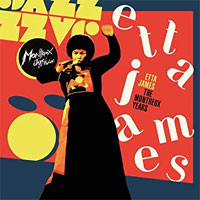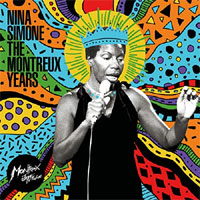Etta James • The Montreux Years BMG 460DCD
Nina Simone • The Montreux Years BMG 461DCD
he Montreux Jazz Festival began in 1967 under the guidance of Claude Nobs and has become a staple of the jazz scene ever since. It has become the premier live-jazz event of the year. Almost from the beginning, Nobs recorded the artists that performed at the Montreux Festival, and those tapes now number more than five thousand. BMG, in association with the Claude Nobs Foundation, began to release selections of various artists' shows on MQA-enabled CDs, starting with these two, from Nina Simone and Etta James. Yes, I know that James is not considered a jazz singer. Nobs realized early on that there was far more great music and many acclaimed artists that did not fall under the "jazz" heading, so he opened the Festival to artists in other genres. I cannot think of two better artists to begin this new CD series with than Simone and James, two performers who could really get the audience involved in their shows. The dates for the tracks on the first Nina Simone CD are culled from shows in 1976, '81, '87, and '90; the second CD contains the full concert from Simone’s initial Montreux performance, in 1968. The tracks for the first James CD come from 1977, '78, '89, '90 and '93 shows, with the second CD a full concert from her European debut at Montreux in 1975. The sound quality is surprisingly very good for all of the live performances. I find it interesting that BMG and the Claude Nobs Foundation have chosen to make these releases MQA enabled. Yes, you can and will enjoy them simply as regular CDs (as I have), but if you can play them back through an MQA-capable DAC, you will get a whole extra level of musical enjoyment (fortunately, I have this capability). The tracks on the first CDs from each artist are chosen well, as they highlight what makes both Simone and James outstanding live performers, but I find the second CDs, of the full concerts, to be the more enjoyable, as they put me in the audience and give the total-immersion feeling of what being there for these shows must have been like. Plus, they let me hear how both artists set up their shows and worked the crowds. The crowd’s reaction to both these wonderful ladies is a part of what makes these discs so enjoyable. Nina Simone began her career by charting a cover of “I Loves You Porgy,” which, as it turned out, was her only hit. But that did not slow her down from becoming a major star in the jazz world. In the ten years she had been singing, she’d never been to Europe, until this invite to perform at Montreux. The second CD is that first show, and the audience ate it up. Her playlist was as varied as one would expect from an artist whose abilities allowed her to tap into many diverse genres and make a song her own. For an example of this, listen to her make the pop song “Don’t Let Me Be Misunderstood” a jazz/pop standard. Etta James was discovered by the great Johnny Otis when she was a mere 14 and he shepherded her early career, including urging her to change her name from Jamesetta Hawkins. By the time of this 1975 Montreux date, also James's European debut, she had honed her style. She always viewed her audience as a motivating factor in her performances, and as you listen, it's clear that the more the crowd gets into the show, the more James makes the show memorable. She is smart, sassy and swinging, and she fuses R&B, blues, soul, and rock into a style uniquely her own. Songs such as “Respect Yourself,” “W-O-M-A-N” and “Stormy Monday” had the crowd enthralled. BMG and the Claude Nobs Foundation choosing these two
artists to introduce this new string of live CDs of performances at Montreux was a wise
decision. Both show what being at the Montreux Jazz Festival was all about. But they also
took two already impressive double-CD sets and upped the ante by releasing them in MQA,
which makes them sound just that much more real. There is a fullness, an organic
wholeness, that is missing from 16-bit/44.1kHz playback, as good as it is. But to me, it
is more what isn’t there in MQA playback that makes these discs stand out. Think of
it like adding a good power conditioner and power cords to your system and then listening
without the noise, grit, and distortions that are usually present. MQA does the same for
the audio signal. These discs play back at 88.2kHz sampling rate, and the MQA versions
provide night-and-day differences, thanks to the way MQA removes unwanted digital
artifacts. |


